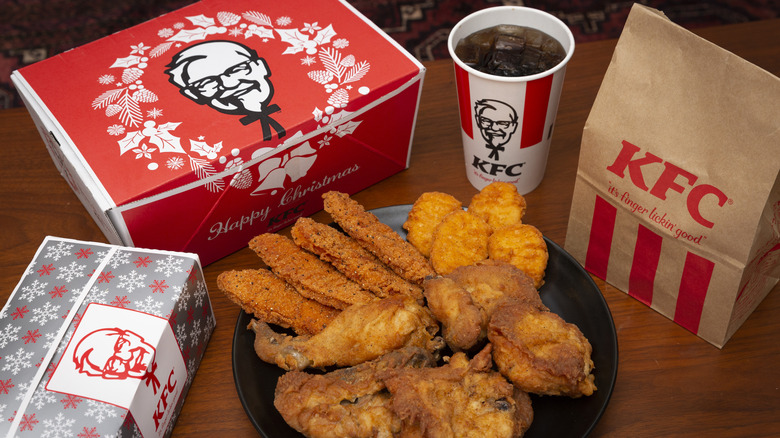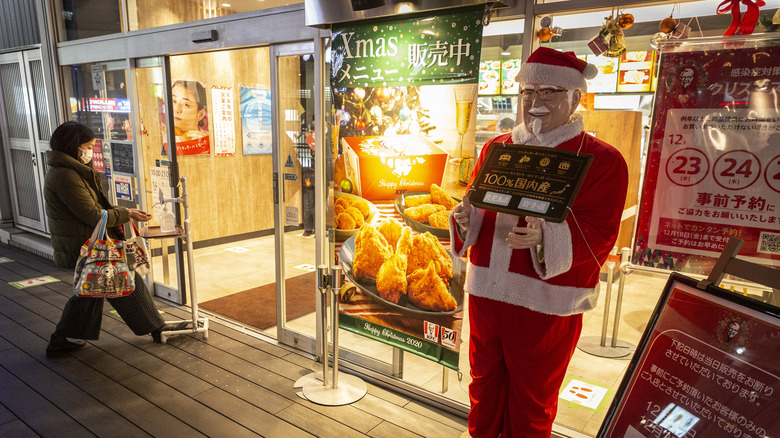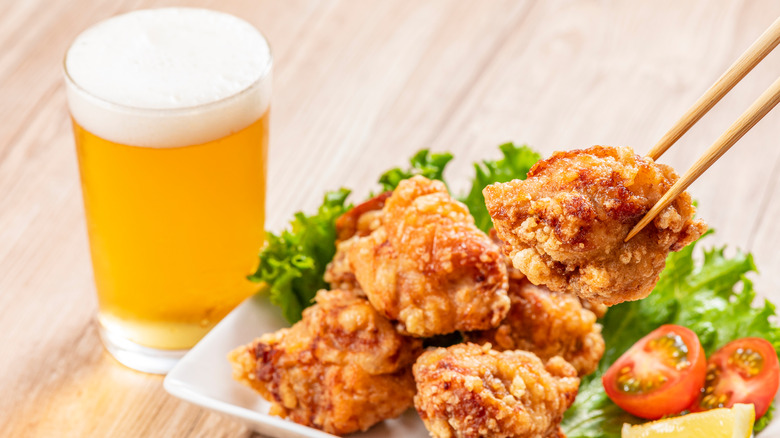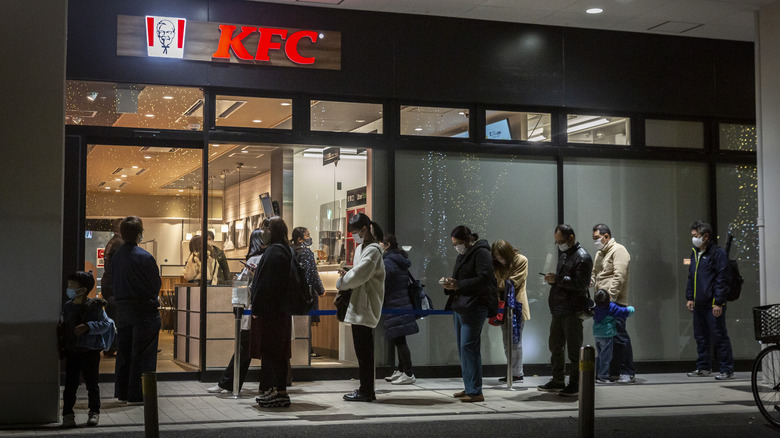How KFC Became Japan's Hallmark Christmas Food
Ah, Christmas food. Maybe you go for a large, typical spread of roast this and roast that with various vegetables and sauces, rolls, and apple pie. Maybe you eat chana masala and biryani, or empanadas and refried beans, or take-away Panda Express of questionable quality, or maybe you don't eat anything special because you don't give two you-know-whats about this whole Christmas thing. Or maybe you live in Japan and queue up outside of a KFC waiting for a deluxe Christmas meal pack of crispy fried chicken like your artery-clogging parents before you.
Hold on, you say: "Folks eat KFC for Christmas in Japan?" Yes, indeed. Feel free to peruse a Japanese-language KFC Christmas menu online; it doesn't matter if you don't read Japanese because everything has a picture. Behold: the Spicy Miso Garlic Chicken Combo, the Chicken Cream Pot Pie Combo, the Chicken Fillet Burger Abundant Combo, and of course, the Cheers Barrel — keep in mind that a barrel is bigger than a bucket.
So how did KFC, of all things, become Japan's staple Christmas food? As Insider explains, it was the work of one man with a keen marketing mind: Takeshi Okawara, who owned the first KFC in Japan in 1970. At a time of intense interest in all things Western, he launched an American turkey dinner-inspired Christmas "party barrel" that substituted fried chicken for turkey. Add to this some family-targeted advertisements in a country that didn't celebrate Christmas (and therefore had no Christmas traditions), and bingo: KFC rules to this day.
11 herbs and spices for 12 days of Christmas
Even though Takeshi Okawara kicked off Japan's annual KFC Christmas binge, his efforts really started to pay off starting in 1974 when KFC's simple "ケンタッキーはクリスマス!" (Kentucky is Christmas!) slogan hit the public, according to Timeout. By the mid-'80s, Colonel Sanders started showing up outside of KFC shops looking like a soul-patched Saint Nick with glasses. KFC Christmas commercials featuring the KFC Christmas jingle "Nice Holiday" — viewable in compilation form on YouTube — started showing up on TV and lodging their way in the minds of children who would become adults who would carry on the KFC-eating custom.
"Every year, I order the party barrel and enjoy it with my family," a 30-year-old woman who lives in Hokkaido told CNN. "I like the delicious chicken and the cute picture plate that comes with it as a bonus."
Speaking of cute picture plates and other kitsch, such inclusions enhance the KFC Christmastime appeal and also make for good nostalgia pieces down the road — Japan's KFC marketing team is still knocking it out of the park. A quick perusal through Instagram pictures show yuletide packaging that's legitimately pretty and well-composed, lovely little dessert cakes and shortbread rolls to top off your poultry, sides like shrimp gratin, and an overall beautiful presentation and festive mood that more than makes people happy to chow down on deep-fried drumsticks year after year. Here's hoping such high standards inspire KFC in countries where fast food is considered trashy, throwaway fare.
Fried chicken: the true national obsession
To be fair, there's another reason that folks go for KFC in Japan at Christmas — one that hasn't gotten enough attention in other articles: Folks are mad about fried food in general in Japan. If your understanding of Japanese people is that they all love sushi and eating healthy, think again. Food like sushi belongs much more to special occasions or family-oriented kaiten sushi (served via sushi-go-round on a conveyor belt). Fried food like chicken is Sunday-to-Saturday fare. And yet, Japan might be the only nation where deep-fried pub grub is presented with more care than fancy and overpriced cuisine in Soho, London or Midtown, Manhattan. If you doubt this, have a look on the Japanese restaurant search-and-reservation site Tabelog at the 133,000+ restaurants in Tokyo alone that serve karaage (pronounced separately like "kara-a-ge," but blended together), aka "fried stuff." That's 133,000+ out of 137,000+ restaurants city-wide, by the way.
At every Japanese fast food joint, convenience store, and izakaya (Japanese-style bar), young adults hurrying to class, drunk people at midnight, and pretty much everyone in between chows down on fried stuff like an addiction, particularly chicken. Karaage specialty shops are not uncommon at streetside festival stalls, or downtown and sit-down style in a tiny room with about six chairs, like the internationally famed Omoide Yokocho in Shinjuku, Tokyo. In other words, if any country's public was primed to welcome a KFC Christmas with open arms, it's Japan.
An annual monetary bonanza
On the financial side of things, KFC has more than enough financial incentive at this point to keep peddling holiday buckets of fried chicken to the good people of Japan. A 2022 KFC Japan press release noted 6.4 billion Japanese yen in sales that year from December 23rd to December 25th alone — that's over $48 million USD by the conversion rate of the time. The release itself points to KFC Japan's corporate philosophy of "creating deliciousness and happiness," a goal that they seem to be doing a fair job upholding. Table Check reports that an estimated 3.6 million Japanese people will likely take part in the nation's 2023 KFC Christmastime fried chicken-eating bonanza.
For those who want to partake in the fowl festivities, there might be a bit of a wait. According to Timeout, some folks book their Christmastime buckets and barrels of KFC weeks in advance. Otherwise, they queue outside of a store for hours, as CNN pointed out. Timeout states that items like the aforementioned Christmas cakes always require reservations, presumably out of a corporate desire to cut costs and make cakes to order rather than overproduce them. Come the end of the year, KFC Christmas advertisements and storefront decorations serve as cues to let people know that it's time to reserve your chicken bucket.
For all those living outside of Japan: Fear not. You, too, could eat fried chicken at Christmas. It just won't look as nice.



